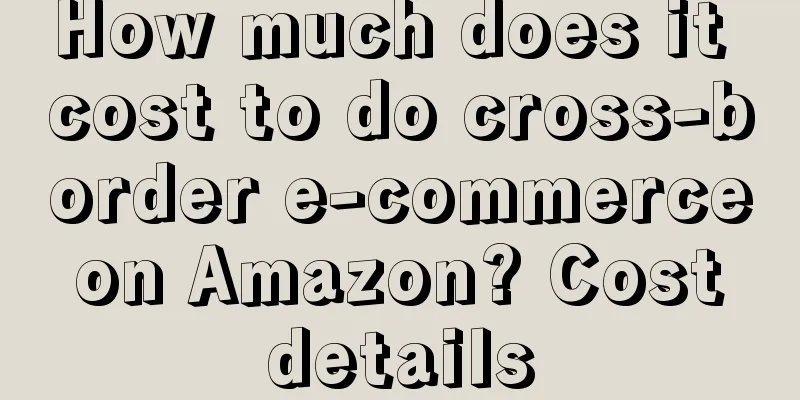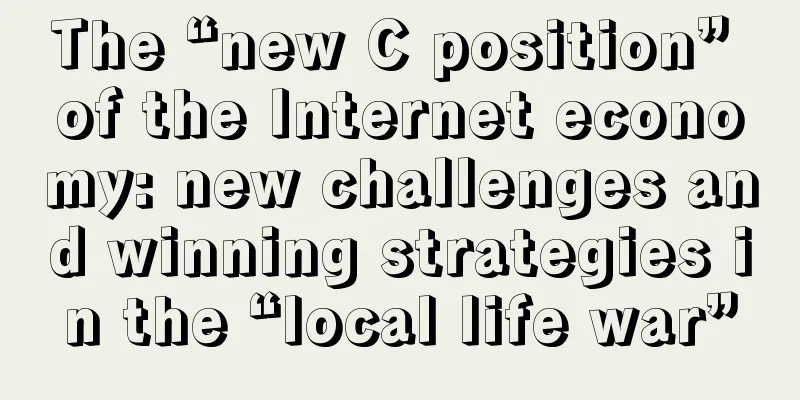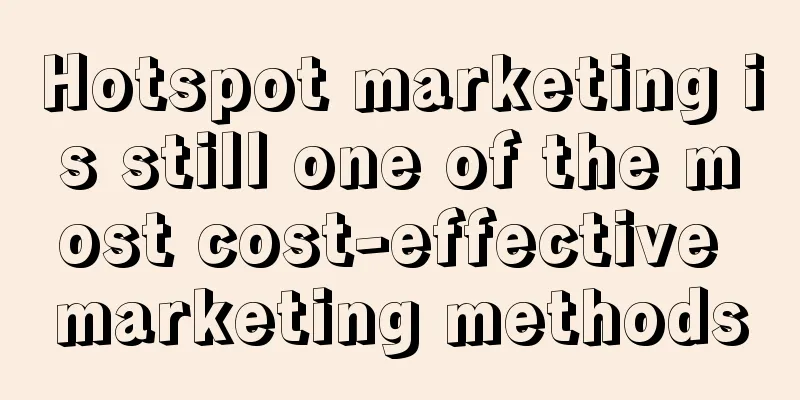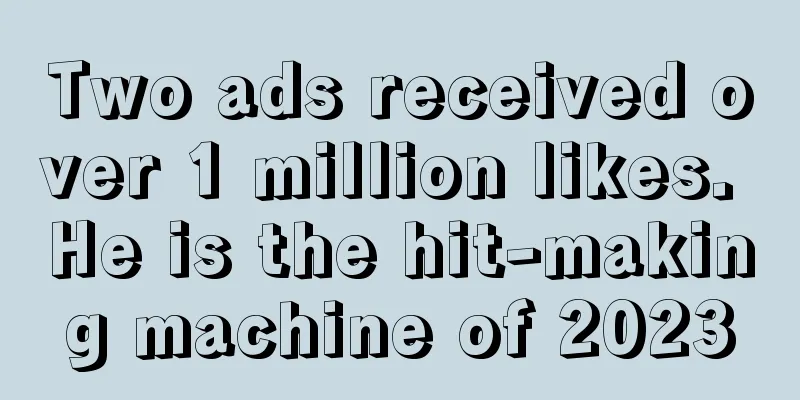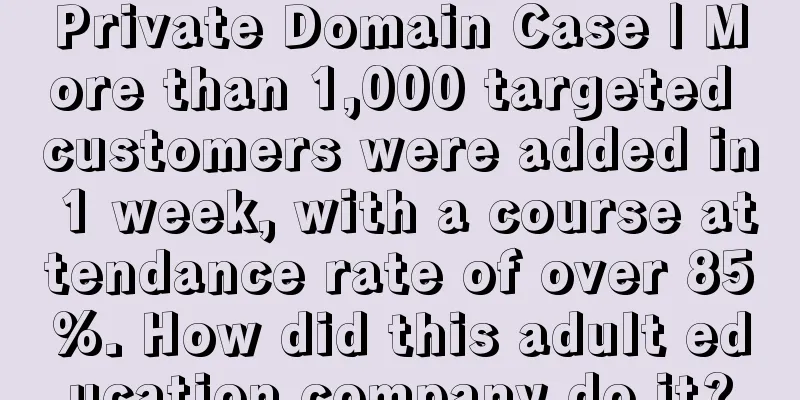Uncovering the secrets of data management in the subsidy war

Business management relies heavily on data analysis, and the most classic application scenario in business operations is the subsidy war. As a platform for bilateral transactions, losing market share means a decline in user experience, which in turn will further affect demand on the demand side. Lower demand will affect supply on the supply side, thus entering an inertial cycle of a death spiral. Therefore, during the subsidy war, everyone will mobilize the best analysts, the best operations operators, and the best business leaders to fight this war of attrition to avoid falling into a spiral. The subsidy war is also a competition between the management capabilities, operational capabilities, data computing power, and execution capabilities of both parties. It is worthwhile for us to talk specifically about the data analysis and business strategy of the subsidy war. 1. Business Competition between the Two PartiesThe essence is to constantly pursue the balance between supply and demand. Let's first talk about the basic logic, which is that the growth of bilateral transactions must be balanced, and the business process is to constantly pursue this balance. It will definitely not work if we only pull up the demand side or only pull up the supply side. Or if the demand side and the supply side are not synchronized, then it will definitely not work. Take online car-hailing as an example. This is a typical two-sided platform. If it is not a dynamic equilibrium process, either the drivers or the passengers will be tossed around. For example, if there are very few passengers and very many drivers, then of course the passengers will be very satisfied, but the drivers will be very dissatisfied. The price is very good for users, but the drivers' income is not enough to make ends meet. Conversely, there are too many passengers and too few drivers. In other words, it is possible that the drivers are very well paid and satisfied, with one order after another, but users will not be able to get a taxi. So this growth has to be balanced. This involves a budget allocation issue. For those who have made annual plans, how much money to spend and to what scale at what time is a specific process of dividing the budget. During the subsidy process, it is necessary to constantly observe the performance of the money on the C-end and the B-end. For example, I have already allocated the money and invested for a cycle, but the demand is not increasing fast enough, what should I do? I adjust the budget, move the money on the B-end to the C-end, and then restore a balance. Because after the money on the B side is reduced, the drivers or riders may be a little bit worse off, but the demand is pulled up quickly enough, and the network effect will bring the interests of all drivers, because the demand for issuing orders has increased, and the income per unit time has increased, which is actually possible to make up for the reduction in subsidies on the supply side. And the growth in the whole equilibrium state is stable, because your certainty, the certainty of your consumer cognition will be established. Consumers perceive the value of your product. There is a key point in the value perception theory, which is that you cannot keep changing. It needs to be a stable cognition in order to have stable retention. For example, if you want to achieve a response rate of 70% in this market, you should stabilize it at 70% and then gradually improve. If you are 70% for a while, 80% for a while, 90% for a while, and then adjust it back to 70%, this is actually not good. Consumer perception must be stable so that your retention can be stable, that is, the impression that consumers have of you can be easily solidified. Another thing is that if we grow after a balance point, and the budget is sufficient, because your C-end response rate and B-end response rate are still increasing, it is a bilateral network that will continue to improve positively, you will save some money, and its growth rate may also have a marginal decrease. At this time, you actually have to face a choice. Should I turn this money into profit to open other cities, or should I invest it in the C-end and B-end to achieve a faster growth rate, or should I invest this money in the industry, or should I improve the product tone to adapt to the consumer perception required by the future market segment of this city. The whole thing is that you need to make judgments for dynamic balance at different stages. When you pass this balance point, the second question about your budget allocation is where to spend the money. 2. Subsidy Wars and Consumption-Based OperationsThe subsidy war is a kind of consumption logic. The whole process requires strategic judgment based on the consumption situation and the opponent's consumption situation. The core is to maintain a certain market share. Market share will affect your consumption. If your market share is low, your profit will be low, and your consumption will be high. The difference in our understanding is that when your market share is maintained at a relatively low level compared to your competitors, although your profit margin is low, your consumption is lower than that of your competitors because your market share is also low. Usually, the top competitors will try to reduce your market share as much as possible. Of course, this is not the only way, and we will explain it in detail below. The subsidy war in the bilateral market has two states. One state is wartime, when there are real competitors. Because the opponent is not a dead person, he will not allow you to develop so healthily. So he has a special consumption logic: the logic is that we have a certain market share, we have our own efficiency, and the opponent also has a certain market share, it has its own efficiency. In this process, once everyone fights, it is possible that they will both be in a state of loss. Because of the characteristics of bilateral networks, this is different from the business of many industries. Once a fight breaks out, it will enter a price war. Both sides are in a loss-making state. Then what is the loss-making state comparing? It is consumption. Whoever has a larger absolute consumption amount will be unable to hold on faster and then exit. This is a temporary consumption logic main line. This is why the business goals focus on gross profit margin and market share. Let me explain this consumption logic in detail below. I have used two companies as an example of this consumption logic. Company A has a market share of about 30%, and Company B has a market share of 70%. Then the gross profit margin of Company A should be negative 70. Company B is negative 50. If we are in a disadvantageous position, assuming we are Company B, we consider that Company A has a larger market share, so they must have a higher basic market share. Here, it is estimated that they are 10 percentage points higher than us. Assuming that our labor efficiency is a little higher, our net profit level should be better. So multiplying the market share, the consumption ratio of both parties is about 0.35:0.21 at the time. That is, although my overall gross profit margin and net profit performance are worse than the other party, because my market is very small, I actually have a slight advantage in consumption. The principle is that because I have a small market share, although my gross profit margin is worse, I can hold out longer in the process of continuous consumption, and the first to retreat must be Company A. However, from the perspective of Company A, there are actually two assumptions that are favorable to it: The first is that Company A fights back and reduces our market share to only 10%. At this time, because its density and revenue duration are higher and our market share is lower, it can seek a state with almost zero gross profit or slightly negative gross profit. At this time, my market scope is too small, so my gross profit margin must be a negative value. It can consume you in the next 10 to 20 years because its gross profit margin is close to zero. It can accept long-term consumption with you. It uses the gross profit and possible gross profit margin of a city to suppress you. You are still in a state of bleeding. It must be willing to do so. This is a possibility, and most companies that enter into a war of attrition want to force the other party to consume quickly by compressing the competitor's market share. The second possibility is that it can give up a certain market share, because its gross profit margin, brand tone and product maturity are advantageous, and its gross profit and net profit are actually still advantageous. It can give up a little share. For example, if it gives up its market share, allowing our company B to reach a market share of 45%. At this time, our consumption may exceed his, and we cannot continue this consumption state. Then we will take the initiative to retreat. Of course, this way of playing is risky. In case we perform well and push it over, he will be in trouble. So generally this plan is not adopted, but it exists in theory. From the perspective of the opponent, he also understands this consumption logic. So in this state of large-scale confrontation where both sides are losing money, the main line of observation is consumption, because it is difficult to improve your gross profit margin in a short period of time, so the main action is to choose to expand market share or shrink market share, and there is also whether to increase or reduce the subsidy intensity. These two sets of variables are the key means of confrontation, and of course there are some tactical means. Everyone should understand this principle. 3. Subsidy for consumption in operation is the coreIf we look back at the subsidy war between Didi and Uber, as well as the subsidy war between Meituan and Ele.me, they all have similar characteristics, namely, two-sided supply and demand platforms and urbanized cellular businesses. As long as you force your competitors into a more consumption state, they will be the first to exit the market due to excessive blood loss. 1. Subsidy wars require calculating survival lines and consuming opponentsIn the subsidy war, operators will require that the market share (number of transactions in the country or a certain city) in the whole country or major cities must suppress competitors. There will be a minimum value of transaction orders, or a certain order transaction volume must be maintained. Behind this is the scale efficiency I mentioned, that is, my density is higher than yours, and my order duration ratio will be higher than yours, which is equivalent to how much money I naturally save on supply-side subsidies. You can think about this principle yourself. Let me explain it in detail below: For example, take delivery riders or drivers, because I need to maintain this dynamic balance to ensure that I will not enter a state where supply decreases, demand decreases, and then accelerates the reduction of supply. When the business stalls, I need to lock in my supply, such as riders and drivers. If in terms of business, my transaction order density in a certain area or city is higher than yours, it means that the income of riders and drivers will be higher than that of competitors. For example, in this dynamic subsidy, I can give 5% less subsidy to the supply side. But competitors need to give 15% more subsidies. My order density is high, and my drivers or riders have high unit income. I only need to give a subsidy incentive to prevent supply loss. But competitors, because their order density is low, they need to give a part of the subsidy to increase the income of the drivers or riders who are missing orders, and secondly, they need to give a part of the subsidy to make up for my subsidy amount. So they need to give an additional 15% to ensure that their supply-side income is consistent with my supply-side. Otherwise, if the long-term operation is consumed, the supply side will migrate to my platform due to the price difference. Therefore, in the subsidy war, the management side will require that the order volume must be maintained within a survival line. The management side will determine a bottom line value for the order volume, which means that if you can maintain this order volume, your competitors will not be able to consume you. For example, if a competitor has fewer cities than us, they do not have business in all cities, but we have more cities than them, so among all the cities we are fighting in, we can maintain a lower survival line in the cities where we are fighting and subsidizing. By maintaining this scale, we can completely suppress our competitors. If they find that it is meaningless to continue to consume, they will either take the initiative to end this consumption state or exit the market. 2. Keeping up with the subsidy war is the basis for winningWhether a platform that is a bilateral transaction can eventually fight out the competition and win the top ecological niche, subsidies are only the basis for you to win in this war of attrition. You don’t have to win in all the wars of attrition, but you need to have the highest capital efficiency under the overall market size. During a training session, I heard a growth analyst’s feedback after reviewing the situation. He believed that in a war of attrition, attrition itself is the result of operations. There are many factors that affect attrition, such as business scale, the scale of cities where you have business, financing capabilities, how much money you have for subsidies, and traffic acquisition capabilities, whether you can acquire users more cheaply. For example, in the subsidy consumption of Didi and Uber, in most cities, Didi's average subsidy rate is relatively low, which is the basis, which ensures that the main efficiency indicators have won the competition, but we also need to admit that this is achieved with the advantage of low customer acquisition costs provided by WeChat and Alipay. This is why the ability to obtain traffic will greatly affect your consumption. Of course, on the other hand, Uber's mature products, high brand tone, and good experience are also Uber's advantages in acquiring customers. And this simple subsidy does not take into account market investment. If Uber's market investment is taken into account, Didi's overall economic efficiency should be higher than that of its competitors, because in this process, Uber emphasizes brand tone to beat the low, so its brand investment in the local market of each city is relatively large, and basically its C subsidy in each city is higher than that of its competitors. The second point is that what influences the outcome is the efficiency of financing. Your capital has an efficiency advantage in terms of scale. That is, the efficiency of using money in terms of your business scale. This is also the fundamental reason why Uber finally withdrew from the Chinese market. In the process of compromising with Didi and others, both parties are actually constantly obtaining financial support from the outside world. That is, new investors join the other side’s camp and provide funds to consume the opponent, affecting the opponent’s bilateral efficiency and forcing the opponent into a negative bilateral effect. So why Uber was asked by venture capital firms to withdraw from the Chinese market? The key is the overall capital efficiency. This is the most critical factor, and this efficiency data cannot be kept secret from both investors. But in fact, in a war of attrition, as long as you can continue to consume and follow your opponent in the core battlefield, rely on multiple factors such as overall scale, traffic acquisition capabilities and financing capabilities to ultimately affect the overall capital efficiency, and gain an advantage in the market, then you will definitely win in such a war of attrition. Therefore, every minute and every second is very precious. As long as you can hold your competitor aside and follow him to consume it, and gain an advantage in the overall situation, victory is possible. Therefore, in this consumption, if you cannot suppress your opponent in the core battlefield, you should keep following up and gain advantages in scale, financing, traffic, and operation to squeeze out the opponent's advantages in the local battlefield. This logic is also explained in the Tsinghua Product Manager Course, which is the number of takeaways. If you open too many cities, the operation and management will be complicated. If you open too few cities, you will not be able to gain similar scale advantages as your opponent. We will not elaborate on this here. 3. How to accelerate the positive cycle between the two sides in the subsidy warHere is a case shared by a friend who works at Uber, which is about how to quickly get both supply and demand into a positive cycle. It goes against common sense, but if you think about it, it is very consistent with the logic of bilateral transactions. First of all, Uber's operations are divided into city teams. Their city teams are organized in the form of elite teams. In the city operations part, it is basically a three-person team, but they don't really distinguish who is on the passenger side, who is on the driver side, and who is the analyst. Then the manager is assigned to this city team. He is running a small team in this way. He may stay in a hotel and work through the Internet to attack one city at a time. In some cities, Uber is very good at creating a positive cycle in the city. Starting from zero, they reached a market share of more than 40% in eight weeks. Starting from zero in provincial capitals, they reached more than 50% in 12 weeks. This speed is very fast, and once they start bilateral transactions in this city, competitors will not be able to reduce their market share. How did they achieve this effect? Let's talk about it in detail. Its efficiency indicator: the growth rate of transaction orders. Compared with other Uber cities, it is quite excellent. This is the principle mentioned above. As long as it is fast enough, it does not waste money. But how can we start bilateral transactions quickly enough? He used a special method. The same routine was used in all other cities, including Chengdu where Uber opened its own business. The first wave of users was to attract a lot of users, that is, highly value-sensitive users. After completing this wave, Uber would start to bring in some healthy users for gradual replacement. In this way, my efficiency may get better and better, because those who take advantage of the users will be slowly kicked out and the scale can be maintained. But the Uber team didn't do that. They repeatedly hit these water users in the second two weeks, because these price-sensitive wool party users can create demand out of thin air. As long as you give them subsidies, they can think about where they want to go today, and then go again. When they see that there is a subsidy, they will find a place to go. This is actually very clever. It makes the demand side very prosperous, and the drivers have strong confidence in their cars. Soon, a healthy state of both supply and demand is formed, and a high level of health is achieved. Later, it will plan how to replace these real users, and the replacement efficiency will be very high at this time because the overall brand confidence has been built up. In this kind of attrition war of bilateral transactions, it is very important to subsidize the user side to generate a very strong demand-side boom. The core is to focus on your own trading network. Don't try to imagine that you fight yours and I fight mine. Can you use a clever differentiation method to fight back? The war of attrition is to follow the opponent, just follow. If you let the opponent enter a high-speed positive cycle of growth, your own method will not maintain your own demand or supply. Then it is equivalent to you and him withdrawing from this city or battlefield. In the war of attrition, do not try to control or force the supply side, although many people believe that the supply will not increase in a short time. Just hold the supply, then it may be useless for you to pull up the demand side. But because when the demand is gone, the supply cannot be maintained on your platform for a long time, and the other party will quickly enter a high-growth state, a continuous positive cycle, to consume you. Once there is not enough demand, these supplies are locked, and your marketing strategy and reward mechanism will be worthless without a large number of real transactions, and you cannot lock it. For the second player in the market, falling behind means falling behind. From the perspective of the overall market, the efficiency of your method must be lower than that of competitors from advanced countries or market leaders. What should you do then? It means imitating the strategies of the competitors on the demand side, following them, and maintaining the bottom line market share of the operation. Sniper the competitors in key cities, and maximize the overall operating efficiency through other methods such as opening cities. Consume the competitors as much as possible in all cities, and do not give up any city easily to consume the competitors. Giving up and exiting means that the competitors have full initiative in this city, and they can use the income of this city to consume you in other cities. If you withdraw from the city, under the budget allocation principle I mentioned earlier, the C-end cannot be maintained at all. You have to give most of the budget to the C-end. In fact, even if you give most of the budget to the C-end, you can't maintain it. You can only stop its momentum. Then the B-end has no budget. How can you maintain the transportation capacity you already have? What should you do? How can you maintain the B-end operation with very little money? Your rewards can be different from those of your competitors, but the difference cannot be too big, otherwise users and supply will migrate to your competitors. Then you have to use very few rewards to defend the supply side. In the same way, if you find that your competitors' operations have become more varied, but the core rewards have not increased, you can judge that your competitors' resources are also insufficient, and in this state, the opponent is about to end the war of attrition. Finally, let's summarize the data management logic of the subsidy war. First of all, this subsidy war is most suitable for bilateral network transactions, where supply and demand are more likely to affect each other. Therefore, when operating a bilateral network, it is important to ensure the dynamic balance of the two sides. Secondly, in a bilateral network with dynamic balance, once subsidies begin, the competing parties will enter into the logic of a war of attrition. In this process of attrition, if you are a top player, you need to squeeze your opponent's market share. Force your opponent to consume faster. Of course, you can also give up some market share. This is feasible in data management. If you are the second in market share, you need to follow up with your competitors to gain global efficiency to win. In the process of following up, do not forcefully control the supply, do not follow your own business direction, but follow the strategy of your competitors. Maintain both supply and demand. The business strategy and consumption of a city are key points in the competition, but they are not the only factors for winning. What matters in the end is the overall global efficiency. Author: Arun's Growth Research Institute Source: WeChat public account "Arun's Growth Study Club" The article was originally published by @阿润’s Growth Research Society on Operation Party. Any reproduction without permission is prohibited. The title image is from Unsplash, based on the CCO protocol. |
<<: From the first milk tea-adapted animation in history, the growth history of Snow King IP
>>: Brand people's four-stage growth strategy (list)
Recommend
Is the Amazon Buy Box Win Rate High? How to Improve It?
There are many consumers shopping on the Amazon pl...
Why are the short-lived delicacies and internet-famous snacks gradually disappearing?
This article deeply analyzes the reasons why Inter...
What to do if Amazon restricts replenishment? How to avoid replenishment restrictions?
When opening a store on Amazon, replenishment is a...
The business department is making things difficult again. What should the data analysts do?
This article will explore in depth the strategies ...
Is there a limit on PayPal withdrawals? How is the handling fee charged?
Nowadays, more and more people are trying to do cr...
Mixue Ice City can't handle the 1.5 yuan issue
Mixue Ice City has developed in the fields of tea ...
Post-new consumption era: the emotional track that has been rolled out, the crazy value of dialogue (Part 1)
In the era of dialogue, the emotional track is goi...
The first batch of bloggers who entered Ailao Mountain have already failed
Recently, Yunnan's Ailao Mountain has unexpect...
From Southeast Asia to Japan and South Korea, Mixue Ice City's overseas expansion
Recently, many netizens posted photos of the grand...
How to choose Amazon operation tools? Operation tool recommendations
Success on Amazon requires long-term efforts. Even...
Do I need to apply for a trademark for each Amazon store? Related questions answered
As the Amazon platform continues to grow, more and...
WeChat has a major revision! The "momo army" has landed in the public account comment area, and the video account link rules have been tightened
This article first introduces the new actions of W...
Video accounts need more "Daolang"
Video accounts have become popular thanks to celeb...
What are the ways to withdraw money from PayPal? How to settle foreign exchange?
Now many friends use third-party payment platforms...
The lowest price on the Internet, driving buyers and sellers crazy
It’s another “Double 11” shopping festival. All ma...

